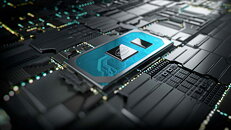Wednesday, February 3rd 2021

Despite AMD Momentum, Intel Claws Back Market Share in Both Desktop and Mobile
AMD's CPU offerings are generally considered to best Intel's competition, especially since the company's Zen 3, Ryzen-5000 series of CPUs launched to great critical and customer acclaim. However, silicon performance can only get you so far - one other issue impacting market penetration is availability of said processors. As AMD fights for constrained wafer supply from TSMC - in no small part due to their focusing of their entire portfolio on the company's highly-sought 7 nm process - users worldwide are generally seeing insufficient stocks of AMD silicon to satisfy their needs. And as such, it seems that at least some users are going with Intel solutions, due to their higher availability in the market.
According to a report from Mercury Research, AMD's constrained chip supply has led the company to a market share loss QoQ. AMD's desktop penetration fell from 20.1% to 19.3% in a single quarter, and its mobile market share saw a similar decrease, going from a 20.1% share down to 19.1%. Of course, not only from market share and shipments are a company's financials made of; AMD ushered in higher ASP (Average Selling Price) for its products, leading the company to a 50% increase in YoY revenue. This doesn't mean AMD is selling less CPUs, however; the x86 CPU market grew a massive 20.1% YoY, so AMD is actually shipping more product than in previous years - it just couldn't account for the entirety of that x86 market increase. Overall, and considering AMD's desktop, mobile, and server markets, the company's x86 market share decreased by 0.7% in Q4 2020 to 21.7% - still a very significant increase, YoY, from its previous 15.5% of the market pie.
Sources:
Mercury Research, via Tom's Hardware
According to a report from Mercury Research, AMD's constrained chip supply has led the company to a market share loss QoQ. AMD's desktop penetration fell from 20.1% to 19.3% in a single quarter, and its mobile market share saw a similar decrease, going from a 20.1% share down to 19.1%. Of course, not only from market share and shipments are a company's financials made of; AMD ushered in higher ASP (Average Selling Price) for its products, leading the company to a 50% increase in YoY revenue. This doesn't mean AMD is selling less CPUs, however; the x86 CPU market grew a massive 20.1% YoY, so AMD is actually shipping more product than in previous years - it just couldn't account for the entirety of that x86 market increase. Overall, and considering AMD's desktop, mobile, and server markets, the company's x86 market share decreased by 0.7% in Q4 2020 to 21.7% - still a very significant increase, YoY, from its previous 15.5% of the market pie.


114 Comments on Despite AMD Momentum, Intel Claws Back Market Share in Both Desktop and Mobile
I call that mixing truth with lies. Demand was unprecedented. However, even if there had been normal demand in Q4 of ~100M PCs, they would have only had 1%.
If Su had said 'We're contractually bound to fulfill PS5/Xbox first, but we wanted to get some out to early adopters to show the market what was coming' - then I'd be perfectly ok with that. Because it would be like, honest.
But that is not what they said, they used the high demand as cover for what was always a low volume paper launch that never had a chance to fill demand, even in normal times.
I think we can give them a pass for Xmas with the launch of Valhalla and CP 20077. I was floored to read somewhere that Epic has 190 million users.
You already established that AMD is killing it in the DIY. It's not like you can't buy a 5600X or 5950X. The 5800X is starting to trickle in but the 5900X is hard to get. It is only the beginning of February. Regardless of how we look at it the internet sale, in a qurantine of PC parts that have seen a 100+% uptick in adoption can cause serious supply chain constraints. Wait till we get the numbers for some of the players. Didn't Logitech have a 95% increase in revenue Y over Y?
I think one can also infer that AMD 'defended' its market share during Q4 by selling through backstock of Zen 2 that it had left, since 1M Zen 3 would be 0.6% of the market and of AMDs 20% share - about 3% of that.
That means 97% of AMDs sales were something other than Zen 3.
So in effect, they got the halo effect of Zen 3 and used it to sell Zen 2.
But the past is the past. Main question is, what happens now.
PS5/Xbox are still sold out. Intel is probably 6 weeks away from starting to get RKL into consumer hands - and will likely do so with tens of millions of units to start, not sub 1 million. TGL-H is out, albeit on the 35W 4 core versions, but we expect to see the 45W 6 cores in March along with RKL.
Allocation in Q4 was 80% PS5/Xbox, so what we see entering the market now is probably the result of the remaining 20%. However, it is Q1 now, and I've seen nothing about what they are allocating in Q1.
Q1 demand should be far lower than Q4, the holidays have that effect every year. So this little bit of easier to get supply of Zen 3 (at this moment, it is sold out everywhere I looked, but to your point I have seen 5600X/5800X stay in stock for hours in the past week vs seconds a month ago) - this may actually be nothing more than demand dropoff following the holidays.
Meanwhile I can get a 10600K at microcenter for $190, and a 10700K for $280, and a 10850K for $350.
Pretty sure we have already established Intel saturates the market to retain sales dominance (along with their shady practices).
But I don't think we can fully blame AMD for this. It's an industry wide problem. Intel is lucky enough to have its own fabs, so they are in a better position, but other than that, AMD, Nvidia, the memory manufacturers, etc., all have problems delivering enough chips and/or are fighting for manufacturing capacity. Even the auto manufacturers are affected by the poor availability of various chips used in the cars and had to reduce production.
I don't see why AMD should have waited more to build a Zen 3 stock. Me and two of my friends already have Zen 3 CPUs, and if AMD would have postponed this launch, I would have probably still been stuck with my old 7700k. So personally, I'm happy AMD had this "paper launch", and I can enjoy gaming on a nearly a silent PC, compared to my previous one that sounded like a vacuum cleaner as soon as I saturated a core.
And if you choose buy Intel because of these availability and price issues, I don't blame you. They are good products, although a bit too power hungry for my taste for 2021.
I'm not happy about this situation either, but it is what it is. You can't build extra manufacturing capacity overnight. I think we'll be lucky if these problems go away by next year.
It's the revenue, and crucially, the profitability that translates into a healthy future (actually, any future at all!)
Now, if only AMD can manage their supply (ermmm,,, 'demand') better, they'll be able to take advantage of an historic period.
In other words, they made a conscious decision to release a product which they had no intention of making in quantity. Logically they might be able to hide behind the supply constraint argument had say 20% or even 10% of their sold units been Zen 3. But it wasn't 20%, nor was it 10%. It was 3%. This was released purely for marketing purposes.
Their priority is OEM, Enterprise, and console with consumer being last. The first two markets provide the biggest revenue for them and console is all mind share. If I was in there position my would have done the same thing. And Intel most likely has the exact same priorities when it comes to allocation production minus a console market. And yes intel still has it own fabs but I don't see them doing it differently.
Mr. Huang who is now pulling down a nifty annual CEO cash compensation of USD$12 million has the same attitude. (Huang holds US$11 billion worth of NVIDIA stock directly under his own name) Reality: With people like Huang, Bill Gates, and or Lisa Lu they are not living any more in the reality of the chickens. The live sheltered away from the chickens behind the gate of a country club community and in mid-century fairway homes. Mr. Huang right now doesn't care about a few bitching DIY's who's 1%-2% marketshare and chicken life revolves around staying in line to buy a GPU. He has bigger fish to fry like putting to good use the USD$40 billion (ARM) aquisition. Maybe he will have a few CPU's coming your way.
The only real thing that has however changed is that hi-tech corporate executives do not have to wear suits anymore, work on campuses and addressing shareholders in T-shirts. No problem, with a total shareholder return of 190%, over three years time all NIVIDIA shareholders are smiling all the way to the bank.